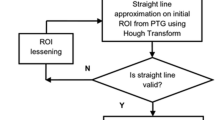Abstract
Mammogram images are majorly used for detecting the breast cancer. The level of positivity of breast cancer is detected after excluding the pectoral muscle from mammogram images. Hence, it is very significant to identify and segment the pectoral muscle from the mammographic images. In this work, a new multilevel thresholding, on the basis of electro-magnetism optimization (EMO) technique, is proposed. The EMO works on the principle of attractive and repulsive forces among the charges to develop the members of a population. Here, both Kapur’s and Otsu based cost functions are employed with EMO separately. These standard functions are executed over the EMO operator till the best solution is achieved. Thus, optimal threshold levels can be identified for the considered mammographic image. The proposed methodology is applied on all the three twenty-two mammogram images available in mammographic image analysis society dataset, and successful segmentation of the pectoral muscle is achieved for majority of the mammogram images. Hence, the proposed algorithm is found to be robust for variations in the pectoral muscle.








Similar content being viewed by others
References
Suckling JP. The mammographic image analysis society digital mammogram database. Digital Mammo, pp 375–86, July 1994.
Gupta R, Undrill PE. The use of texture analysis to delineate suspicious masses in mammography. Phys Med Biol. 1995;40(5):835–55.
Hatanaka Y, et al. Development of an automated method for detecting mammographic masses with a partial loss of region. IEEE Trans Med Imaging. 2001;20(12):1209–14.
Karssemeijer N. Automated classification of parenchymal patterns in mammograms. Phys Med Biol. 1998;43(2):365–78.
Saha PK, et al. Breast tissue density quantification via digitized mammograms. IEEE Trans Med Imaging. 2001;20(8):792–803.
Ferrari RJ, et al. Segmentation of mammograms: identification of the skin-air boundary, pectoral muscle, and fibro-glandular disc. In: Proceedings of 5th international workshop on digital mammography. Toronto, Canada; 2000.
Kwok SM, et al. Automatic pectoral muscle segmentation on mediolateral oblique view mammograms. IEEE Trans Med Imaging. 2004;23(9):1129–40.
Chandrasekhar R, Attikiouzel Y. New range-based neighbourhood operator for extracting edge and texture information from mammograms for subsequent image segmentation and analysis. IEE Proc Sci Meas Technol. 2000;147(6):408–13.
Raba D, et al. Breast segmentation with pectoral muscle suppression on digital mammograms. In: Iberian Conference on pattern recognition and image analysis. Springer, Berlin, pp 471–8; June 2005.
Yapa RD, Harada K. Breast skin-line estimation and breast segmentation in mammograms using fast-marching method. Int J Biol Biomed Med Sci. 2008;3(1):54–62.
Karnan M, Thangavel K. Automatic detection of the breast border and nipple position on digital mammograms using genetic algorithm for asymmetry approach to detection of micro-calcifications. Comput Methods Programs Biomed. 2007;87(1):12–20.
Mustra M, Grgic M, Rangayyan RM. Review of recent advances in segmentation of the breast boundary and the pectoral muscle in mammograms. Med Biol Eng Comput. 2016;54(7):1003–24.
Rampun A, et al. Fully automated breast boundary and pectoral muscle segmentation in mammograms. Artif Intell Med. 2017;79:28–41.
Mustra M, Grgic M. Robust automatic breast and pectoral muscle segmentation from scanned mammograms. Sig Process. 2013;93(10):2817–27.
Otsu N. A threshold selection method from gray-level histograms. IEEE Trans Syst Man Cybern SMC. 1979;9:62–6.
Kapur JN, Sahoo PK, Wong AKC. A new method for gray-level picture thresholding using the entropy of the histogram. Comput Vis Graph Image Process. 1985;2:273–85.
Oliva D, et al. Multilevel thresholding segmentation based on harmony search optimization. J Appl Math 2013;2013:1–24.
Poli R, et al. Particle swarm optimization: an overview. Swarm Intell. 2007;1(1):33–57.
Ghamisi P, Couceiro MS, Benediktsson JA, Ferreira NMF. An efficient method for segmentation of images based on fractional calculus and natural selection. Expert Syst Appl. 2012;39(16):12407–17.
Olivaa Diego, et al. A multilevel thresholding algorithm using electromagnetism optimization. Neuro-computing. 2014;139:357–81.
Horng M. Multilevel thresholding selection based on the artificial bee colony algorithm for image segmentation. Expert Syst Appl. 2011;38:13785–91.
Pal SK, Bhandari D, Kundu MK. Genetic algorithms, for optimal image enhancement. Pattern Recognit Lett. 1994;15:261–71.
Sathya PD, Kayalvizhi R. Optimal multilevel thresholding using bacterial foraging algorithm. Expert Syst Appl. 2011;38(12):15549–64.
Kumar AS, et al. Fractional-order darwinian swarm intelligence inspired multilevel thresholding for mammogram segmentation. In: 2018 (ICCSP). IEEE, 2018.
İlker Birbil S, Fang S-C. An electromagnetism-like mechanism for global optimization. J Glob Optim. 2003;25:263–82.
Cowan EW. Basic electromagnetism. New York: Academic Press; 1968.
Author information
Authors and Affiliations
Corresponding author
Ethics declarations
Conflict of interest
All the authors declare that they have no conflict of interest.
Additional information
Publisher's Note
Springer Nature remains neutral with regard to jurisdictional claims in published maps and institutional affiliations.
Rights and permissions
About this article
Cite this article
Avuti, S., Bajaj, V., Kumar, A. et al. A novel pectoral muscle segmentation from scanned mammograms using EMO algorithm. Biomed. Eng. Lett. 9, 481–496 (2019). https://doi.org/10.1007/s13534-019-00135-7
Received:
Revised:
Accepted:
Published:
Issue Date:
DOI: https://doi.org/10.1007/s13534-019-00135-7




